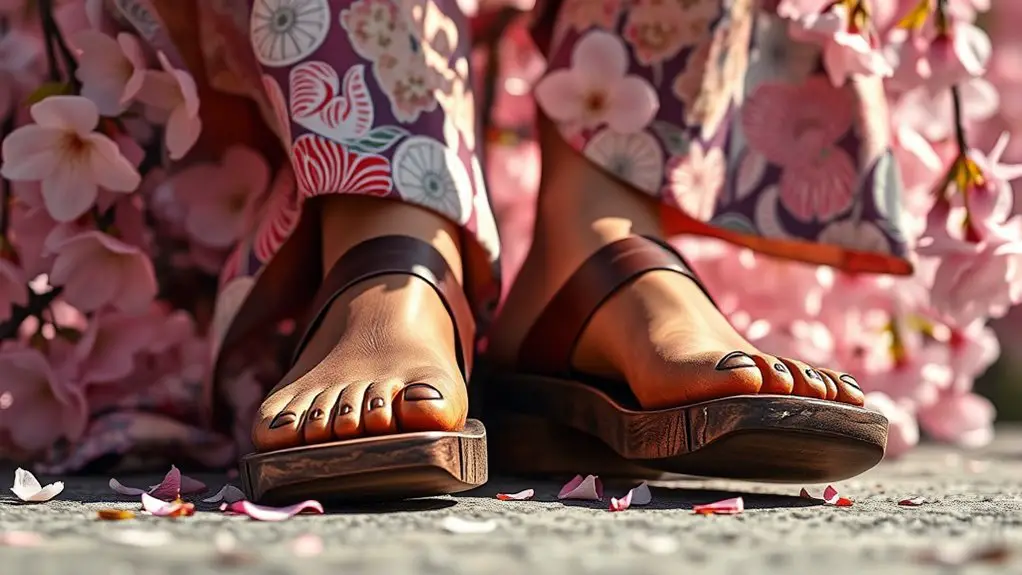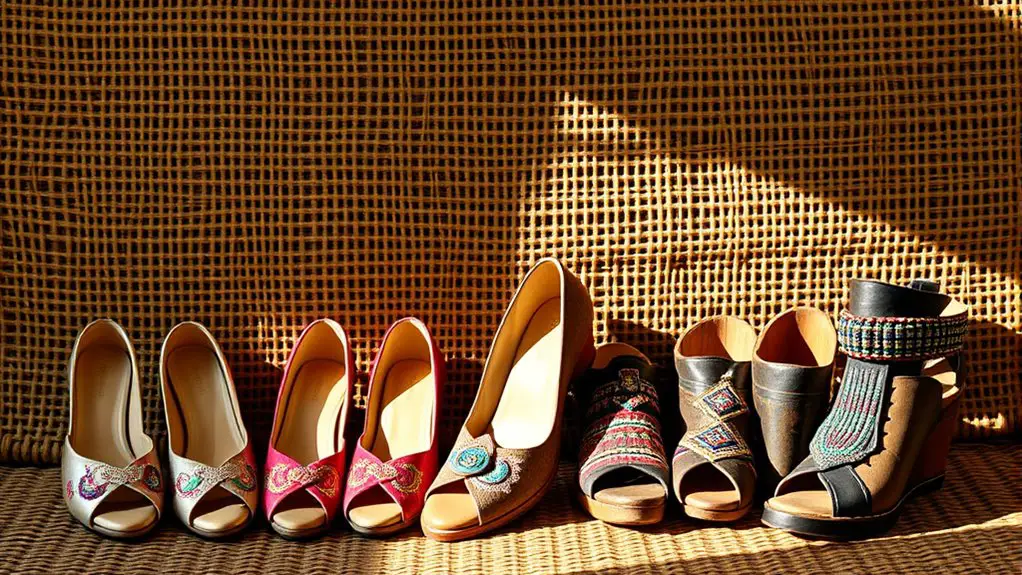Traditional heeled shoes vary widely across cultures, each telling its own story. For instance, the Geta of Japan emphasizes practicality and protection from rain, while Flamenco heels highlight passion and dance expression in Spain. In contrast, the stiletto represents Western glamour, showcasing a desire for elegance and status. Indian Juttis feature intricate craftsmanship reflecting cultural heritage, whereas Masai sandals symbolize resilience and a connection to the land. Each design encapsulates unique cultural values and histories, hinting at the rich narratives behind them.
The Geta of Japan: A Blend of Tradition and Functionality

The wooden geta, a distinctive footwear choice in Japan, exemplifies a unique blend of tradition and functionality that sets it apart from Western heeled shoes. While Western heels prioritize elevation and aesthetics, geta craftsmanship focuses on practicality and cultural symbolism. You’ll notice that the elevated design keeps your feet dry in wet conditions, serving a practical purpose rooted in Japan’s rainy climate.
The craftsmanship involved in creating geta is meticulous, often featuring intricate carvings and natural wood variations that reflect regional artistry. Each pair tells a story, intertwining with Japanese customs and festivals. In contrast, Western heels may symbolize status or fashion trends, often sacrificing comfort for style.
Flamenco Heels: Passion and Performance in Spanish Culture
Flamenco heels, with their striking elevation and vibrant designs, encapsulate the essence of Spanish culture and the art of dance. These shoes aren’t just footwear; they’re an essential part of flamenco history, symbolizing the passion and intensity of the performance. Unlike other traditional shoes, flamenco heels are crafted to enhance dance expression, allowing performers to execute intricate footwork while creating a rhythmic sound that resonates with the audience.
The sturdy heel provides not only elevation but also stability, allowing dancers to express their emotions through powerful movements. In contrast to ballet shoes, which prioritize grace and fluidity, flamenco heels demand strength and precision, emphasizing the cultural storytelling inherent in every performance. This juxtaposition showcases how footwear can influence dance styles and cultural expression, making flamenco heels a unique representation of Spain’s rich artistic heritage, where each step tells a story and every heel strike echoes the dancers’ fervor.
The Iconic Stiletto: A Symbol of Western Glamour
While many shoes serve functional purposes, the stiletto transcends mere practicality, becoming a powerful symbol of Western glamour and sophistication. Its stiletto history traces back to the 1950s, when designers like Roger Vivier and Christian Dior popularized the slender, high-heeled design that accentuated femininity. As fashion evolution continued, the stiletto became synonymous with power, often seen on red carpets and in corporate settings alike.
You can’t help but notice how the stiletto stands out against other heeled shoes, like wedges or block heels, which prioritize comfort. Yet, while those styles may be more practical, they lack the striking elegance that a stiletto embodies. This juxtaposition reflects a cultural obsession with beauty and status in the West, making the stiletto not just a shoe, but a statement of identity and ambition. In this way, it represents both the allure and the complexities of modern femininity.
Indian Jutti: Craftsmanship and Cultural Significance
Juttis, with their intricate designs and vibrant colors, embody the rich cultural tapestry of India. The craftsmanship behind these shoes is exceptional, showcasing the skills passed down through generations. When you explore juttis, you’ll notice:
- Materials: Traditionally crafted from leather, embellished with embroidery or sequins, they reflect regional artistry.
- Designs: Each jutti often tells a story, with patterns symbolizing local traditions or historical events.
- Occasions: Worn at weddings and festivals, juttis hold significant cultural value, linking wearers to their heritage.
Comparatively, jutti craftsmanship stands out due to its meticulous attention to detail and the unique cultural narratives they convey. Unlike Western shoes, which often prioritize modern aesthetics, juttis maintain a connection to India’s diverse history and customs. Their cultural significance is profound, making them not just footwear but a celebration of identity and artistry.
The Masai Sandal: Tradition and Resilience in East Africa

Though often overlooked in discussions of global footwear, the Masai sandal stands as a symbol of the resilience and cultural heritage of the Maasai people in East Africa. These sandals, crafted from locally sourced materials, showcase exceptional Masai craftsmanship that reflects a deep understanding of the environment. Unlike the ornate designs of traditional heeled shoes, Masai sandals emphasize functionality and durability, designed to withstand the rigors of daily life on the savannah.
The cultural significance of these sandals goes beyond mere utility. They represent a connection to the land and the Maasai’s nomadic lifestyle, embodying a sense of identity and pride. When you compare them to other footwear, the Masai sandal’s simplicity speaks volumes about the values of sustainability and tradition. In a world increasingly dominated by mass production, the Masai sandal remains a demonstration of cultural resilience, reminding us of the beauty found in authenticity and purpose.
Frequently Asked Questions
How Do Cultural Beliefs Influence Shoe Design Across Different Societies?
Cultural beliefs shape shoe design profoundly; in one society, they might symbolize status, while another emphasizes practicality. Historical significance intertwines with these beliefs, creating diverse expressions of identity and functionality that reflect deeper cultural narratives.
What Materials Are Commonly Used in Traditional Heeled Shoes Globally?
When exploring traditional heeled shoes, you’ll find various materials like leather types, including cowhide and suede, alongside textile variations such as silk and cotton. Each choice reflects regional aesthetics and functional needs, enhancing cultural significance.
How Have Modern Trends Affected Traditional Heeled Shoe Styles?
Like a chameleon adapting to its environment, modern influences have reshaped traditional heeled shoe styles. Fashion evolution blends comfort with aesthetics, merging classic designs and contemporary trends, creating unique hybrids that reflect today’s diverse tastes.
Are There Specific Occasions for Wearing Traditional Heeled Shoes in Various Cultures?
In many cultures, traditional heeled shoes are worn during wedding ceremonies and festive celebrations. You’ll notice how styles can vary, reflecting unique customs and values, while some designs symbolize status or heritage, enhancing the occasion’s significance.
What Role Do Traditional Heeled Shoes Play in Cultural Identity?
Traditional heeled shoes carry cultural significance, serving as a means of identity expression. You’ll find they reflect social status, tradition, and personal beliefs, highlighting how footwear becomes a powerful symbol within various cultural narratives.



